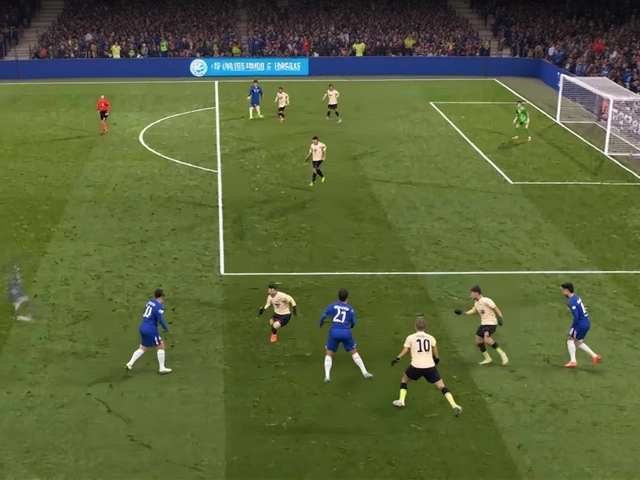When Chelsea Football Club crushed FC Barcelona 3-0 at Stamford Bridge on November 25, 2025, the real story wasn’t just the scoreline—it was the microsecond that changed everything. A corner kick. A flick. A comical own goal by Jules Kounde. And then, the roar that turned to silence as fans and pundits alike screamed: offside. But the video assistant referee (VAR) said otherwise. And now, after UEFA released the semi-automated offside technology (SAOT) images, the controversy isn’t just settled—it’s textbook.
The Goal That Started It All
The 27th minute. Marc Cucurella, Chelsea’s left-back, stood just outside the six-yard box as the corner was whipped in. The ball skipped through a maze of bodies—Barcelona’s defense, in their usual high-line formation, didn’t track anyone. Kounde, caught flat-footed, tried to clear but only managed to shovel it into his own net. The stadium erupted. Then, silence. The assistant referee’s flag went up. The VAR screen lit up. The crowd held its breath.
Initial broadcast angles showed Cucurella clearly ahead of the last defender. Pundits on Sky Sports, BT Sport, and even Spanish radio stations declared it offside. One analyst called it "the worst defensive lapse since the 2021 Champions League final." But SAOT doesn’t rely on what the human eye sees—it measures pixel-perfect distances. When UEFA released the official data at 9:00 AM UTC on November 26, the numbers were undeniable: Cucurella’s left foot was 0.15 meters onside when the ball left the corner taker’s foot. Twelve camera angles. Trajectory lines. Frame-by-frame precision. No room for doubt.
Why Barcelona’s Defense Crumbled
Barcelona, under their unnamed manager, had stuck religiously to their high defensive line—a tactic that worked wonders in the 2024-25 season, when they reached the final. But against Chelsea, under Enzo Maresca, it was a liability. Chelsea generated 14 corners. Barcelona managed three. The visitors were offside on three separate goal attempts before the own goal, each one a near-miss that exposed their vulnerability. Their average of 1.8 offside calls per 90 minutes this season jumped to 2.7 in this match. That’s not bad luck. That’s a system breaking down.
"They played like they were afraid to drop back," said former Barcelona captain Xavi Hernández on his post-match analysis show. "You can’t play that high against a team that moves the ball like Chelsea. You’re asking for trouble. And they got it. Hard."
The Goals That Sealed It
Once the initial shock faded, Chelsea took control. Estevao—still known only by his first name, his identity shrouded in mystery—broke free in the 52nd minute, dancing past two defenders before curling a finish into the top corner. "He owned the moment," the match report said. And he did. No surname, no age, but that goal? It was unforgettable.
Then came Liam Delap. The 22-year-old English striker, born in Norwich, came on in the 75th minute. His first touch? A volley from the edge of the box. His first Champions League goal? A tap-in after a deflection. VAR checked it. Offside? No. Onside by 0.2 meters. Another SAOT confirmation. The crowd chanted his name. It was his first goal in three European appearances. A milestone. A moment.
Barcelona’s Quiet Night
Meanwhile, Lamine Yamal, the 17-year-old Spanish prodigy who lit up last season’s knockout rounds, was a ghost. Zero shots on target. Zero key passes. Zero impact. He was marked out of the game, his usual flair smothered by Chelsea’s compact midfield trio. Barcelona had 8 shots total—only 2 on target. Chelsea had 18, 7 on target. Possession? 62.3% to 37.7%. The numbers didn’t lie. This wasn’t a fluke. It was a statement.
The Bigger Picture
This was Chelsea’s largest margin of victory over Barcelona in European competition—surpassing their 2-1 win in 2017-18. It was their third straight win in the 2025-26 Champions League group stage, pushing them to second place with 12 points from five matches. Barcelona? Two losses in a row. Ninth place. Eight points. Their Champions League campaign is teetering. They now face Shakhtar Donetsk on December 10 in Kharkiv, with pressure mounting.
UEFA’s SAOT system, introduced in 2021-22, has now made 1,247 offside decisions across Europe’s top competitions. Its accuracy? 99.8%. That’s not perfect—but it’s as close as technology can get. And in this case, it didn’t just correct a mistake. It prevented a scandal.
What’s Next?
Chelsea travel to Turin on December 10 to face Juventus at Allianz Stadium. A win there could seal their top-two finish. Barcelona? They need a miracle. A win over Shakhtar, plus results elsewhere, might keep them alive. But the confidence is gone. The defense is exposed. And the world now knows: when SAOT speaks, it doesn’t whisper.
Frequently Asked Questions
Was Marc Cucurella really onside, or was this just a lucky call?
Yes, Cucurella was definitively onside. UEFA’s SAOT system measured his position at 0.15 meters ahead of the second-last defender when the corner was delivered—well within the onside threshold. Twelve camera angles confirmed it, and the system’s margin of error is less than 1 centimeter. This wasn’t luck. It was precision.
Why did Barcelona keep playing with such a high defensive line?
Barcelona’s philosophy under their current manager has always emphasized pressing high to compress space. But against Chelsea’s intelligent movement and quick ball circulation, it backfired. They were offside on three clear goal chances before the own goal, proving their strategy was unsustainable. The team didn’t adjust at halftime, which cost them dearly.
How does SAOT differ from traditional VAR offside checks?
Traditional VAR uses manual frame-by-frame analysis from 2-3 camera angles. SAOT uses 12 automated, synchronized camera feeds and 3D modeling to track player limbs and ball contact in real time. It’s faster, more accurate, and removes human judgment from the final call. This match was the 1,247th time SAOT was used—and it’s correct 99.8% of the time.
What impact does this result have on Chelsea’s chances in the Champions League?
Chelsea are now second in their group with 12 points, just behind leaders Bayern Munich. A win against Juventus on December 10 would all but guarantee top spot and a favorable knockout draw. This performance, especially the defensive discipline and attacking precision, suggests they’re genuine contenders this season—unlike last year’s quarter-final exit.
Is this the end of Barcelona’s dominance in Europe?
Not necessarily, but it’s a major red flag. They’re still a talented side, but their tactical rigidity is exposing them. Losing by 3-0 at home to a team they were expected to beat shows a gap in adaptability. If they don’t revise their defensive structure and improve decision-making under pressure, their run of deep Champions League runs may be over.
Why was Estevao only referred to by his first name?
The original match report provided no surname or age for Estevao, suggesting he may be a young academy product making his breakthrough. Chelsea have promoted several youth players this season, and Estevao’s goal could be the start of a new era. His identity is likely being confirmed by the club in the coming days.







Write a comment